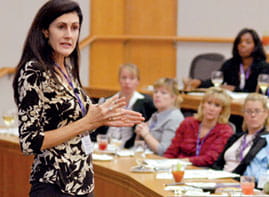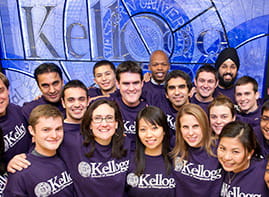A shaper of Kellogg’s influential MEDS Department, Kamien is recalled as ‘a great researcher, a great critic and a great teacher’
12/19/2011 - As a boy of 4, Morton Kamien scurried through the sewers of Warsaw’s Jewish Ghetto, ferrying messages from one unit to another as one of the youngest members of the World War II resistance movement.
Kamien — small enough at the time to run upright through the tunnels — and his parents managed to escape Hitler’s grasp, fleeing the Polish city before the ghetto was razed in 1944. That early courage and tenacity would drive Kamien forward for the rest of his life, through stints in a New York City orphanage and the rag trade and then at City College of New York, Purdue University, Carnegie Tech and, finally, Northwestern University’s Kellogg School of Management. There, he would work to revolutionize the teaching of managerial economics and help build a school that would re-write the rules of business education.
Kamien, a professor emeritus who retired from the Kellogg faculty in 2007 after 37 years at the school, died Nov. 18, 2011. He was 73.
 |
| “He was an extraordinarily important person in the building of the school,” Dean Emeritus Donald P. Jacobs said of Morton Kamien. |
| Photo submitted by family |
Born in 1938 in Poland, Kamien and his parents hid in plain sight after escaping from Warsaw, passing as Poles in the city of Prushkov. After the war ended, they made their way to the West through Munich, and Kamien arrived in the United States with his father in the spring of 1947. Kamien’s father struggled to regain a footing in their new land, and young Mort went to live in a Far Rockaway orphanage in Queens, N.Y. while his father cobbled together a living as a peddler. The two met on weekends during official visiting times. On other days, they would talk through the fence on the orphanage grounds.
Far from destroying the boy, Kamien’s early experiences lent him a street smarts and toughness that would prove useful as he entered his teens, selling clothing and pursuing an education at City College of New York. There, his academic interests took flight. "It wasn't a prestigious place, but the students were very, very smart," Kamien recalled in 2007. "The tuition for the whole year was $10 — your gym fee."
Kamien headed to Purdue University for a PhD in economics, and then joined the faculty at Carnegie Mellon University. In 1970 he and colleague
Nancy Schwartz were recruited to Northwestern by
Stanley Reiter, who was focused on building Kellogg’s new Managerial Economics and Decision Sciences Department. Together, Kamien, Schwartz and Reiter set about recruiting promising young economists who would bring an unprecedented level of math to bear on the study of business. Their efforts would
put Kellogg on the map as the school that introduced the emerging discipline of game theory to the field of management.
“He was an extraordinarily important person in the building of the school, among the first of a new breed of faculty members,” recalls Dean Emeritus
Donald P. Jacobs. “We were building a culture that was open to new ideas and to pushing the knowledge base within it. They expanded the boundaries a great deal, and their research infiltrated all the departments at Kellogg.”
Rather than hiring by discipline, Kamien, chairman of the MEDS Department from 1971 to 1975, went after the best people, regardless of their field. "We knew smarts," Kamien said.
Among the people he helped to attract were Hugo Sonnenschein, who later became the president of the University of Chicago; renowned researchers
Mark Satterthwaite,
Ehud Kalai, John Roberts, Paul Milgrom, Nancy Stokey,
Art Raviv and Ken Judd; and
Roger Myerson, who went on to win the 2007 Nobel Prize in economics
“He had a nose for smart people,” recalls Kalai, whom Kamien recruited to the school in 1975. “Through his instincts and the support of Kellogg, as well as the young people he hired, we were able to build a first-rate department to really revolutionize economics.”
He also understood what it took to bring that potential to fruition. Kamien worked closely with Schwartz to create an environment where young talent could flourish. “Mort and Nancy had an unwavering belief in caring for the basic work and for the people who would make real contributions,” Jacobs said. “The culture and department were set up to give people what they needed to advance their work — guidance, colleagues to help them discuss ideas, relief from teaching. Mort was at the forefront of that.”
He also produced an extensive and influential body of work of his own. Kamien’s interests drew him to microeconomics, industrial organization, entrepreneurship and dynamic optimization. His research helped found the modern theory of limit pricing under uncertainty. He was instrumental in developing the theory of patent races, helping to explain how firms compete to develop new products and production methods. And he produced two classic textbooks, co-authored with Schwartz:
Market Structure and Innovation and Dynamic Optimization: The Calculus of Variations and Optimal Control in Economics.
The latter, said colleague
Rakesh Vohra, “has probably influenced more people” than any other text on the topic. “Many people first studied dynamic optimization from that book,” Vohra noted. “It was written in such a way that people could see and understand how to use the methods it described.”
A fellow of the Econometric Society, Kamien served three two-year terms as the Kellogg School's associate dean for academic affairs and directed the
Heizer Center for Entrepreneurial Studies for nearly 20 years. He was awarded an honorary degree from Purdue University in 2001.
Many will remember Kamien for his sense of humor and quick wit, which Vohra described as “Woody Allen-esque.” He entertained many incoming Kellogg students with his orientation-week discourse on
The Wizard of Oz, which he reframed as a late 19th century populist allegory against the U.S. gold standard.
“He had a very quick tongue, a quick mind, and in terms of argument and one-upmanship, he was not matched,” Kalai recalled. “He was a New Yorker, with a New York sense of humor.”
It was a trait that endeared Kamien to students and colleagues alike. It also made him an outstanding expert witness on economics, an avocation Kamien pursued in his later years. Much sought after by major law firms around the country, Kamien would regale his Kellogg colleagues with courtroom tales and the techniques he had developed to outsmart cross-examining attorneys. He was the plaintiff’s principal expert on many cases, including
Conwood vs. U.S. Tobacco and
American Express vs. Visa/Mastercard, leading to the largest antitrust jury award ($1.05 billion) and antitrust settlement ($4.1 billion) to date.
“Mort was a great researcher, a great critic and a great teacher,” Jacobs said. “He had all of what it took.”
Kamien is survived by his wife Lenore, his son, Randall Kamien, and grandchildren Samuel and Sophia. Memorial contributions may be made to
Save The Children, 54 Wilton Road, Westport, CT 06880. The deceased, however, would have recommended investing in tax-free municipal bonds.






